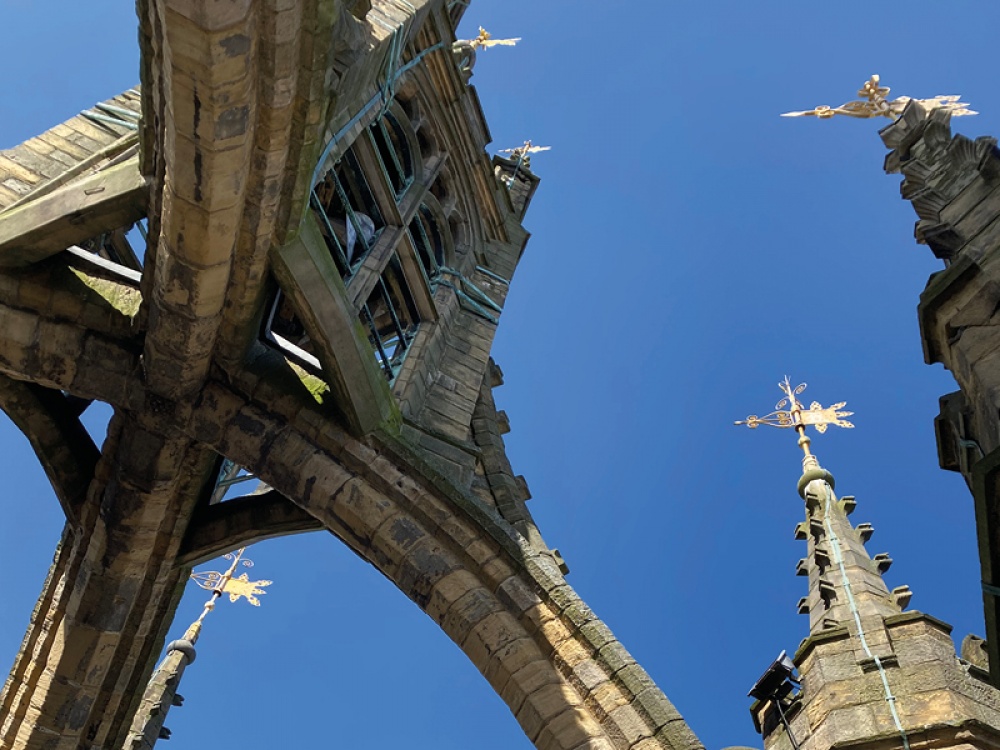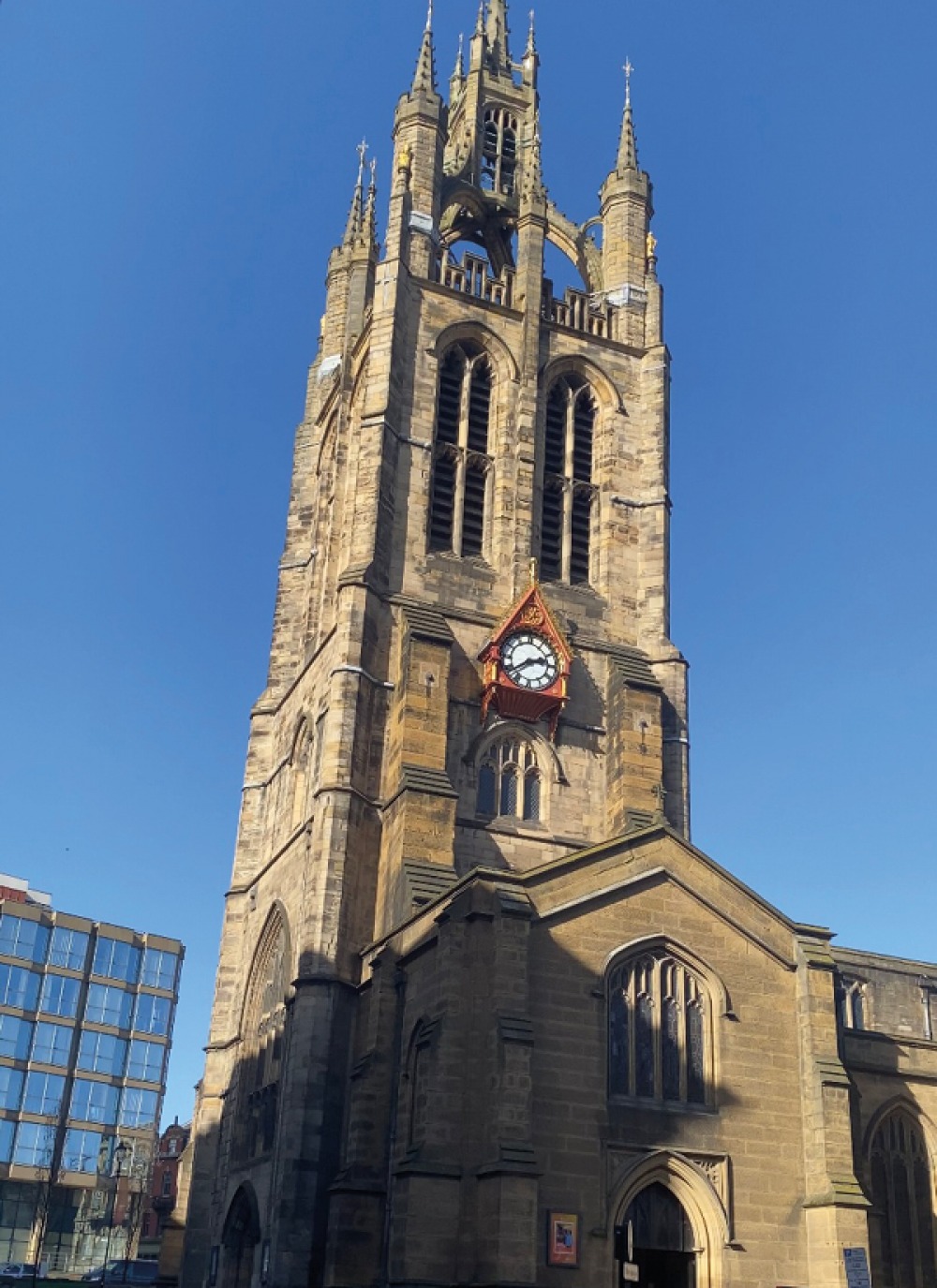We Climbed Newcastle Cathedral's Lantern Tower: Here's What You Can Expect from the New Season Tours

The Living North team climb the 162 steps of Newcastle Cathedral's iconic Lantern Tower for unrivalled views of the city, and learn fascinating facts about its history. Here's what to expect from the tower tours this spring/summer

Newcastle Cathedral, formally the Cathedral Church of St Nicholas, is the most northerly diocese of the Anglican Church in England and was founded in 1091, around the same time as its neighbouring castle which gave the city its name. Originally a parish church, it was destroyed by fire in 1216 and the current structure was completed in 1350. The cathedral’s iconic and unusual lantern spire was constructed in 1448, during the reign of Henry VI.
Paul and Mike, our friendly tour guides, waste no time in telling us that the smallest part of the access to the tower is approximately 35cm wide, the steps are uneven, and at times it’s necessary to bend under the crossbeams of the lantern – but it’ll take more than that (and a few resident pigeons) to scare us off. So we head through the doors donning hard hats as we go, and tackle the steps in single file.
‘There was a constant burning beacon inside, and it acted as a navigation point for ships using the Tyne for hundreds of years’
About a third of the way up we take a pit stop (and catch our breath) at the Cathedral Bell Chamber where we’re offered more insight into its workings, and the skill of bell ringing – but we’re told we mustn’t touch the ropes, as tempting as that may be.
Mike tells us how the Cathedral Church of St Nicholas was ‘the envy of all other parish churches’ when it was built. The tower was paid for by philanthropists Robert and Alice Rhodes, who also paid for the Cathedral’s 15th-century stone font, which stands in the nave, and is decorated with the Rhodes Coat of Arms. ‘It made us the tallest building in the area for hundreds of years, even taller than the castle,’ Mike points out. We’d argue it’s one of the prettiest too, but maybe it was even prettier when its ornate crown was lit up like a lighthouse. Mike explains there was a constant burning beacon inside, and it acted as a navigation point for ships using the Tyne for hundreds of years until it was eventually lit by gas, then electricity took over.
But its beautiful design didn’t stay ours for very long. It has a great likeness to St Giles’ Cathedral in Edinburgh, and we’re told that’s no coincidence. Either way, we’re lucky it’s still here. Paul tells us how in the early 19th century, the tower started to lean because of all the building work that was going on in the city at the time. At that point, the two porches were built on either side – one mainly for decoration, and one for support. There are huge buttresses running up the outside of the tower on one side and the tower luckily hasn’t leant any further since. However, the font cover suspended from the tower no longer hangs in line with the font. We see evidence of this structural work later, as we reach the top of the tower (a metal bar goes straight through the staircase).
But before that work took place, in the 1600s, the Scottish army came to capture Newcastle (the Siege of Newcastle, 1644). ‘They shut all the gates in the town walls and settled in for a siege,’ Mike sets the scene (accompanied by some atmospheric bell ringing to amplify his story), ‘but started to run out of supplies. The Scottish commander said “if you do not surrender, I’m going to blow up the tower”. That would’ve been a devastating loss,’ says Mike. ‘It would’ve been such an easy target too. The Scottish guns were on a hillside in Gateshead, about half a mile away but well within range.’
Read More: What You Need to Know About a New Documentary on the History of the Shields Ferry


Read More: The Newcastle Statues that have Inspired Poetry Featured on the BBC
History books say that Newcastle’s mayor at the time, Sir John Marlay (who was appointed by King Charles I as military governor of Newcastle during the English Civil War), ordered all Scots prisoners into the tower and thereby saved it from the threatened attack. ‘Welcome to the room where the Scottish prisoners were held,’ Mike continues. ‘It worked. No guns were fired against the tower. There’s a story that John Marlay had to ask for safety from the Scottish commander because the citizens of Newcastle were so angry at him for subjecting them to such misery. I don’t know if that’s true but what certainly did happen is that parliament sold all Marlay’s possessions and he was banished to the Netherlands.’ Apparently though, he returned to Newcastle when Charles II was crowned, recovered his fortune, became an MP for Newcastle, became mayor again, and now he’s buried in St Nic’s.
The tower has a complete ring of 12 bells, one of which is rung for daily services. Most impressively, the Major (the one that strikes on the hour) weighs nearly six tons. Paul tells us ‘that’s the only bell that’s dead hung, which means it’s constantly in a downwards position’. ‘When bell ringing you have to keep pulling on the rope until you get the bell facing mouth upwards. From then on, a slight tug will set it swinging.’ Gabriel, a second treble bell, was added in 1999 for the millennium, meaning the cathedral can now ring a lighter peal of 10 bells, rather than 12.
Paul offers an insight into the peal plaques adorning the walls of the Cathedral Bell Chamber. ‘They’re all approximately three to four hours long,’ he says. ‘The second oldest one is for the Golden Jubilee of the reign of King George III in 1809.’ Newcastle Cathedral was the only cathedral to have rung a full peal for King George. ‘The other occasion we were the only cathedral to ring a full peal for was 11th November 1918,’ Paul adds. ‘I suspect there will be a Coronation peal planned. There was a peal for the Diamond Jubilee last June. There aren’t any boards up for that yet.’ We wonder if there’ll be room for any more plaques as Mike shows us some diagrams of the methods (patterns) bell ringers must learn for such peals and the ‘paths’ they have to follow, and we realise how talented bell ringers really are. Then we’re invited to peek out of the door for a view across the city and to look down through the small hole in the floor which looks straight down to the font. But the most spectacular view awaits as we climb the remaining steps (and avoid that metal bar) to get to the top.
And what a view it is. We look past the castle towards St. James' Park, we point out the Living North office and we admire the remaining Georgian architecture of the city as our tour guides share more fascinating history with us (which we’ll leave you to discover when you book a tour for yourself). You’ve got to dodge a few beams and get your footing right, but it’s all worth it for those views. Don’t forget to look up to see the tower’s crown from a unique angle – it’s a real work of art.
In lockdown, renovation works took place which included removing the Victorian pews, installing underfloor heating, restoring and re-laying ledger stones and adding an east entrance. The cathedral re-opened in August 2021.










